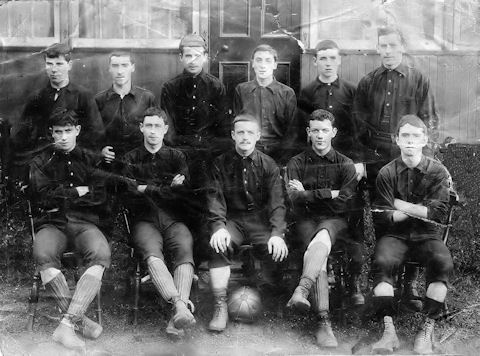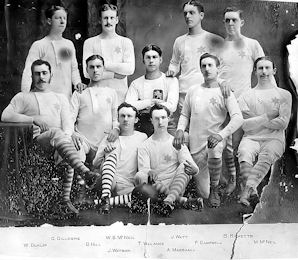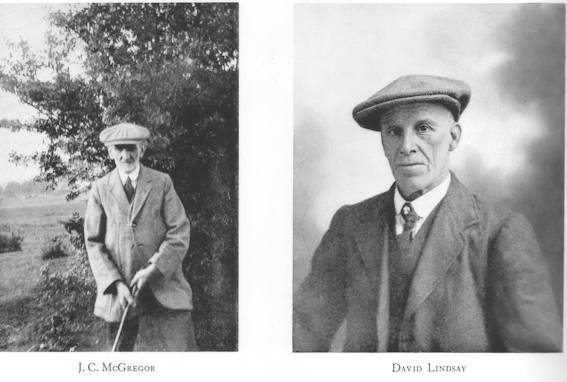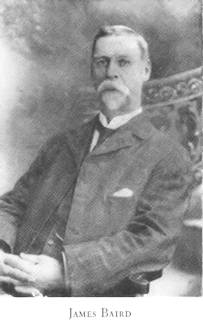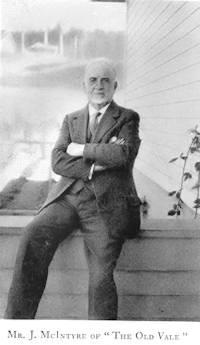Season 1877 – 78 - A second Cup win in succession and a first trip down South
An excellent (if a wee bit damaged) picture of an old VOLFC team has been sent to us. This looks really old but the players faces are all quite recognisable. It looks as though it may just be a general team picture as opposed to one taken after winning a trophy as there there is no trophy on display.
Have a look at it and if you can offer any information about any of the players or the team we would be very grateful. Click the image to display a larger version in a new window.
2 June 2012 We were grateful to receive this email from Gunter Ashton who lives in Russia ...
"Hello, I'm from Russia.
I'm writing to you because as a guess that the team is shown in this photo. Apparently this picture of the 1880s - is likely to 1886-1888, since then the team has played young Jimmy Cowan in the future, the great Aston Villa midfielder."If you click the small image it will expand to a team picture of Aston Villa in 1891. It is clear that Gunter is correct. The same Jimmy Cowan can be seen in the back row, second left of the Vale of Leven picture above. (Jimmy Cowan entry in Wikipedia.)
In the fourth round of season, 1877-78, the Vale again met Rangers. After a 0-0 draw at Kinning Park, the Vale won the replay at North Street Park 4-0. They then proceeded without difficulty to the final where on the 30th March 1878 they beat Third Lanark 1-0 in a poor game at Hampden Park in front of 5-6,000 spectators to retain the Cup.
This win brought the Vale an invitation to travel down to England to play the winners of the English FA Cup, Wanderers. Queen’s Park had regularly made this journey and indeed both Queen’s and Third Lanark played in the FA Cup until banned from doing so, by the SFA. Both also played fairly regularly in England over the years. However, the Vale was the first Scottish team, other than Queen’s Park, which had been invited down as winners of the Scottish Cup to play the winners of the FA Cup. This was an exact forerunner of the game which in 1888 someone had the good marketing sense to term “The World Championship” and which was won in the only year in which it was competed for under that title, by Renton FC.
The Vale team and officials set out from Alexandria station on the evening of Thursday11th April 1878 in a private North British Railways carriage which took them all the way to King’s Cross Station, London. This was a big event for the wider Vale community and a large and enthusiastic crowd turned up at the station to see them off. To the players themselves, who were an abstemious self-disciplined group, this was definitely something of a jolly boys outing, a reward for a couple of very successful seasons.
It was also a holiday, something that as ordinary working men they would only have taken locally. Although the Vale players definitely did not belong to the archetypical Scottish footballer-toper of later generations, a small libation was partaken of on the overnight journey south. Dancing and piping displays were held on station platforms along the route, and since this was still in the days before corridor trains, players hung out windows to pass drink from one compartment to another. All very modern behaviour you might think. They arrived in London on the Friday morning looking and feeling hung-over, but had the good sense to make an early night of it on the Friday night.
Their opponents entertained them royally, and on the morning before the game the Vale party went to watch the Oxford and Cambridge Boat race on the Thames. From there it was a short journey to what is now best known as a cricket ground – the Kennington Oval. When they ran out onto the Oval, then as now the home of Surrey County Cricket Club, to play Wanderers, they were facing the most formidable team in England. All of the Wanderers players were ex-public schoolboys. They had won the FA Cup in 1872, 1873, 1876, 1877, 1878. Because of these last 3 successive victories the FA had given them the Cup to keep permanently. Nobody knew quite how the game would go and certainly no one expected the comfortable 3-1 victory which the Vale team produced.
The post-match banquet was probably as great a challenge for the players as the game had been. The hosts were more than generous and gracious in defeat, and if they had lost to the Vale boys at football, they fully intended to even the score in eating and drinking. The FA Cup which Wanderers owned* was produced and a great many toasts were drunk from it as it was passed round. The chairman for the evening was AC Kinnaird, a Wanderers player and also a Scottish Internationalist. He was actually Lord Kinnaird who had a family seat in Perthshire, and later became a very popular President of the Football Association for many years right into the 1920’s. That night he proposed the Toast to the Vale of Leven FC; the Vale players were on the big stage now, only 6 years after the Club’s founding. Who could believe it? Well, the Vale players for starters, who took it all in their stride - which probably had a wee stagger in it on the way home.
* Wanderers later handed the FA cup back on the condition that it would not be subsequently offered to any other club in similar circumstances.
What that meant was that the original FA Challenge Cup trophy continued to be presented for a single year’s retention until 1895, when it was presented to Aston Villa for the second time. Villa placed the trophy on public display in a shop window, from where it was stolen and never recovered. At that time the second (current) trophy was commissioned. It is because of these circumstances that the Scottish FA Challenge Cup is the world's oldest football trophy still in use.
(Our thanks to Brian Wright for this information.)
Season 1878 – 79 – Three in a row and dearie me, what a stramash!
The Vale took up in season 1878-79 where they had left off in the previous season and made it to the final almost effortlessly. In the final they again met Rangers, on April 19th at Hampden Park. This was to prove to be one of the most noteworthy of all Scottish cup finals, with a mixture of the dangerous, the comic and the dramatic.... and then there was the football. There were, of course, some matters hanging over from the last meeting of these two teams in a Cup final two years previously, with Rangers nurturing a grievance from these games.
Rangers had by now built up a considerable following in Glasgow and so great was the crowd that a section of the pavilion collapsed before kick-off. It was reported by the Lennox Herald that it was likely that this was the largest crowd “ever to have tried to watch a game in Glasgow, both inside and out.” The start had to be delayed for about half an hour, and when the game got under way Rangers soon scored. They then had a goal disallowed, a decision against which they later appealed on the basis that the ball had indeed crossed the line, but had hit a spectator and rebounded into play. In the second half, the Vale equalised and that was the score which stood – a 1-1 draw. The game would have to be replayed the following week.
The Vale team which played in this game was:
R Parlane in goal; backs A McLintock and A McIntyre; half backs J McIntyre and J McPherson; forwards J McFarlane, J Ferguson, James Baird, Peter McGregor, JC Baird and J McDougall, captain.
Rangers were incensed by what they saw as a goal that was not given, and decided to protest. They produced what on the face of it even now seems to have been a credible witness, if such a thing can be found at any football match, never mind a Cup Final - the man whom they said the ball had hit and bounced back into play. He was not just any football fan, but a knight of the realm and the professor of surgery at Glasgow University. He said publicly that indeed the ball had gone over the line and in for a goal, hit him and then rebounded from him back into play. It would be unworthy for even a Vale fan to doubt that this upright gentleman was telling the truth. However, that didn’t change the fact that the referee did not see the goal being scored and his umpires disagreed about whether or not it was a goal. Just as in the previous Cup Final between the two teams, the referee could not give what he had not seen, still a guiding principle for referees. The second guiding principle was that goals could not be awarded after a game had finished, and that is still also the case. So on the evening of Monday 19th the SFA Committee dismissed their appeal and ordered the replay to be played on the upcoming Saturday, April 26th. If an injustice had been done, then it could be sorted out in the replay.
How Rangers thought that there could be any other outcome to their appeal is still puzzling. Anyhow, not getting their own way, they decided to throw their toys out of the pram and they refused to turn up for the replay the following Saturday. The Vale and the officials duly did appear and took to the pitch at the appointed time. With no show from Rangers the referee awarded the game and the Cup to the Vale. That decision needed to be ratified by the SFA, and a few days later the SFA duly award the Cup to the Vale. The entry for season 1878 – 79 (on the Cup itself, not the plinth) reads “Vale of Leven, Rangers did not appear”. Needless to say Rangers never again did not turn up for a Cup Final game – although strangely enough, the Vale did five years later, in what were rather different circumstances.
That was 3 Scottish Challenge Cup wins in a row, but it was also the end of the Vale’s run of luck in the Cup and although the Vale got to 4 more finals, they never again won the Cup. It was also the beginning of the end for the players who had brought so much early glory to the Vale – the so-called “Old Vale Team”.
The Vale’s Cup Winners and the Loving Cup
Only seventeen men played in the Vale FC teams which won the Scottish Cup for 3 years in succession, and they are listed below. Many years later, when the players had retired from the game, an annual reunion of the cup-winning players was started by the players themselves. This soon developed into a more grand affair with invited guest and this grander re-union which went on for more than 30 years, was paid for by James Ferguson, joint author with JG Temple of “The Old Vale and Its Memories” and The Epilogue to that book, who was a wealthy London-based Valeman. These grander reunions started by taking the form of a cruise on the Loch on James Ferguson’s steam yacht followed by lunch in a Loch-side hotel. The surviving Old Team members who still lived in Scotland – and until about 1898 all of them still lived in the Vale – and many of the great and good of Scottish football such as James Kelly of Renton and Celtic, and Tom Vallance captain of Rangers in the controversial 1-1 game of 1879, were fixtures at the function. The numbers attending the annual outing outgrew the steam yacht and graduated to a Loch Steamer – some years more than 100 people attended. Eventually the trip went further afield to such places as Alloway and Turnberry but as numbers of surviving players declined, it returned to the Loch.
Naturally the Old Vale Team players’ achievements gave great pleasure and pride and very fond memories to the people of the Vale. Three Vale supporters and attendees at the annual re-unions decided to give tangible form to these feelings and commissioned a Loving Cup to be held in turn by each player. Each player was to hold the Cup for one year after which it was passed on to another, and so on every year. The last survivor of the Old Vale Team would keep the Cup. The annual Old Vale Team trip was the perfect venue for the handing over of the Loving Cup.
The idea of a Loving or a Grace Cup was a very old one, in Scotland and elsewhere, and it took various forms. Sometimes it was and is used at annual ceremonies where each person takes a drink from it and passes it to his neighbour at the table (it is said that this is how it got the name of the Grace Cup in ancient Scotland, because it was only by passing round the cup full of good wine that you could keep Scotsmen at the table until the saying of grace). There are now other Loving Cups in football, but the Vale’s Loving Cup was the first.
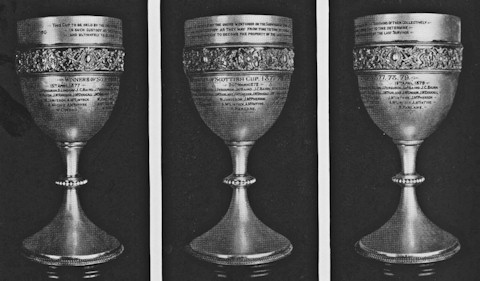
The Loving Cup showing all of the engraving on the trophy. In fact the engraver made
a few errors, but it’s the spirit of it all that counts. Now on display at the Scottish Football
Museum at Hampden. (Click to Enlarge)
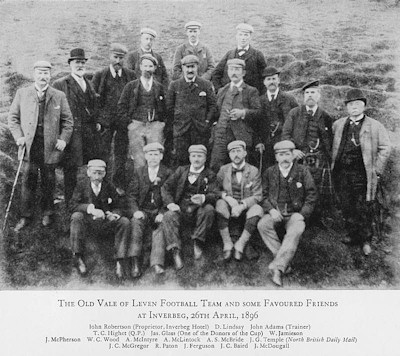
The Old Team trip to Inverbeg 1896, which is first photo we have of the outing.
It’s also interesting because 2 of the 3 donors of the Cup
are in it - James Glass and AS McBride. Click to Enlarge.
We are grateful to Rangers fan, Alex Lister for sending us a couple of interesting images from this era.
Alex writes, "I just read your pages about the Vale of Leven team that won the cup in 1877 against The Rangers.
I have to say, fantastic images and article, despite having it's leanings towards The Vale, I as a Rangers fan, and early scottish football enthusiast enjoyed reading it. I thought these two images may have been of some interest to you".
The first is an invitation from Thomas Vallance, a member of the Rangers team who played against Vale of Leven in the 1877 Scottish cup final. This invitation was to a 21st anniversary celebration (in 1898) of that final.
It reads, "TOM VALLANCE Requests the Presence of Mr. J.S. McKenzie to SUPPER in the METROPLITAN 40 HUTCHISON STREET on the occasion of the 21st ANNIVERSARY of the FINAL CUP TIE PLAYED ON 13th APRIL 1877."
The second image is of the Rangers team who played in the 1877 final.
G. Gillespie, W. B. McNeil, J. Watt, S. Rickett, W. Dunlop, D. Hill, T. Vallance, P. Campbell, M. McNeill, J. Watson and A. Marshall.
Moses McNeil, Peter Campbell and Tom Vallance who are in this picture were founding members of Glasgow Rangers FC along with Peter McNeil (Moses' brother) and William McBeath.
You can click these images to display the enlarged versions.
As well as the inscription detailing the purpose and the annual handing over of the Cup to another player, there is a further inscription which briefly describes its origins. It reads:
“The Loving Cup for Auld Lang Syne is given in richt guid hert and will.
Frae three aul’ callans o’ the Vale. 19th May 1900”
Thus we now know when it was first presented to the Old Vale Team and that the three donors were indeed Vale men, supporters rather than businessmen. About two of the donors not a lot is known at the present. True, Mr Glass appears in a photo of the first OVT trip taken in 1896 at Inverbeg, and he is described by J G Temple as a “great Vale supporter”, but the best we can come up with about Mr McAdam is from a speech at the 1925 outing in which he is described as living opposite Jamestown school in the speaker’s childhood, which would have been the 1870’s.
The best known of the 3 men who commissioned and paid for the Cup was Andrew S McBride and the other two were named James Glass and a Mr McAdam whose Christian name is not known. They were neither jewellers nor in business together in Alexandria, as is sometimes said. McBride was a man of many talents – ex President of the Vale FC and the SFA, elected top of the poll to the new Bonhill School Board in 1873, Vice-President of the Vale Liberal Association, a great lover of Scotland and its heritage, much in demand at Burns Suppers, a poet and author in his own right, and a leading West of Scotland Mason. He had worked in what became the UTR until well into his 70’s and when he died in 1923 aged 79, he was buried in Millburn Church Yard.
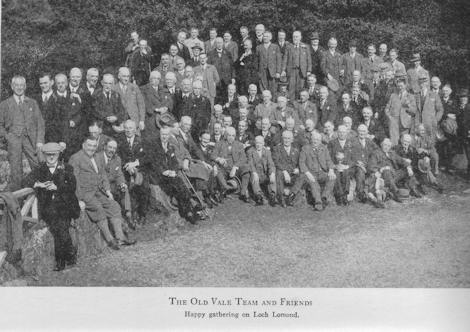
Inverbeg 1928, the last Outing for which we have a photo.
Just look at the number of guests by this time. Click to Enlarge.
The various outings provided a rich harvest of team photos from 1896 until 1928 which appear in “The Old Vale” and “The Epilogue” – the latter book was printed in 1929, so any later trips have gone unrecorded. By that time only 6 members of the Old Vale Team were still alive and living in Scotland, and a further 2 died in 1929, so the re-unions probably did not go on much beyond 1929. It was assumed that Cup remained in the surviving players’ hands until the death of the last of them, Andrew McIntyre, in 1941 and that after Andy’s death his family entrusted it to the Vale of Leven District Council. That underestimates the foresight and civic responsibility of the Old Vale players.
By 1933 there were only two surviving members of the Old Vale Team – John or Jack McPherson and Andy McIntyre – whose thoughts had by now turned to what was to happen to the Cup after they were both dead. In the absence of any other instructions it was feasible that the family of the last survivor could hold on to the Cup in perpetuity, but that was not how these men thought. They believed it belonged not to them but to the whole Vale community and they were seeking a final resting place for the Cup which would keep it safe in the Vale and available to members of the public.
In November 1933 a meeting was therefore held between the two of them, the Cup’s trustee (who was the son of AS McBride one of the donors of the Cup) and J Ferguson who had paid for the annual outings for 30 years or so. All agreed that the Cup should be handed over immediately to the Vale of Leven District Council and that it should be kept in the safety of the Council Chambers in Gilmour Street in Alexandria. Naturally the Council were delighted to be asked to become custodians of the Cup, although they initially didn’t realise that the hand-over was to take place immediately.
As soon as this misunderstanding was cleared up, a hand-over ceremony was arranged and in January 1934 Andy McIntyre handed the Cup over to Sir Iain Colquhoun, the then chairman of the Council, and into the Council’s safe keeping. Unfortunately John McPherson could not attend because he had met with an accident and he was to die in March 1934 just 2 months after the hand-over.
The aspirations of the players and the trustees and the promises of the Council were duly met and for 40 years the Cup rested safely in Gilmour Street in the care of the Vale District Council. Then came local government re-organisation in 1974 and the use of the Gilmour Street building changed – most of it became the Alexandria Library. This would have seemed an ideal place to display the Cup, but not so and it became yet another Vale artifact to make the trip, one-way only as far as successive councils are concerned, from the Vale to Dumbarton. As if this weren’t bad enough, it was stuck away in a cupboard where it would no doubt still be were it not for the interest and tenacity of a journalist, Jim Hossack, of the short lived newspaper, the Sunday Standard. The Loving Cup now occupies its proper place in the SFA Scottish Football Museum at Hampden Park where its story of team and community pride and loyalty continues to command respect from followers of the great game.
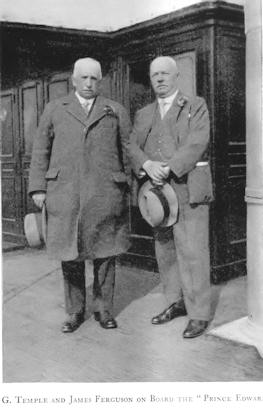 There are actually a couple of engraving mistakes on the Cup. One of which appears twice and the other has the effect of erasing from the Loving Cup record the appearance of one player from the Cup’s Roll of honour. Both are easy to explain.
There are actually a couple of engraving mistakes on the Cup. One of which appears twice and the other has the effect of erasing from the Loving Cup record the appearance of one player from the Cup’s Roll of honour. Both are easy to explain.
In 1878 and 1879 JC Baird’s name appears as JC Bairn – presumably the engraver just copied the mistake from one year to the other, although he did get it right at the outset in 1877. However, everyone knew who JC Baird was, and his photo appears with the many others in this entry, so no great damage was done.
The other mistake is that in the 1879 list of forwards, JC McGregor is listed as having played. He did not, but Peter McGregor played in his place. Again it looks like a straightforward engraver’s error with J McGregor occupying the same place as he did on the 1878 entry, but poor old Peter McGregor is written out of the Loving Cup, although not of the newspaper reports. Nothing more is now known about him.
JG Temple and James Ferguson, who paid for the Outings for about 30 years are picture right. Together they wrote “The Old Vale & Its Memories” and “The Epilogue”.
Click image to Enlarge >
The 17 cup-winning players were:
| No. | Surname | First Name | Psn. | 1877 | 1878 | 1879 | Life | Cap |
| 1. | Wood | W C | G | Y | N | N | ? -1898 | |
| 2. | McIntyre | Andrew or Andy | FB | Y | Y | Y | 1855-1941 | 2 |
| 3. | Michie | Archie | FB | Y | N | N | ||
| 4. | Jamieson | Will | HB | Y | Y | N | ||
| 5. | McLintock | Alexander / Sandy | FB | Y | Y | Y | 1853-1931 | 3 |
| 6. | Ferguson | John | F | Y | Y | Y | 1848-1929 | 6 |
| 7. | Paton | R or Bob | F | Y | N | N | 1854-1905 | 2 |
| 8. | McGregor | John C or Johnny | F | Y | Y | N | 1852-1930 | |
| 9. | McDougall (capt) | John | F | Y | Y | Y | 1853-1925 | 5 |
| 10. | Baird | John C or Jackie | F | Y | Y | Y | 1856-1902 | 3 |
| 11. | Lindsay | David | F | Y | N | N | 1853-1929 | |
| 12. | Parlane | Robert | G | N | Y | Y | 1848-1918 | 3 |
| 13. | McPherson | John C or Jack | HB | N | Y | Y | 1855-1934 | 8 |
| 14. | Baird | James or Jamie | F | N | Y | Y | ||
| 15. | McFarlane | Johnny | F | N | Y | Y | ||
| 16. | McIntyre | James | FB | N | N | Y | ||
| 17. | McGregor | Peter | F | N | N | Y |
All came from the Vale, and most worked in the local textile finishing works. Even the ones who went to England to play as professionals returned to the Vale to work when their playing days were done. Three of them worked in Ferryfield Works – John McDougall, Andy McIntyre and Sandy McLintock, while Johnny Ferguson, David Lindsay and WC Wood worked in the Craft; JC McGregor became a foreman in the UTR, and the last of them, Andy McIntyre, worked in Dalquhurn until his retirement. So they were local men in every sense. So far, some have proved pretty resistant to research, but quite a lot is known about many of the others, which can be summarized as follows:
1. WC Wood, goal-keeper in the 1877 cup-winning team. He was the first of the team to die, in 1898, and his death was keenly felt in the Vale, being as it was the first break in the great Vale cup winning teams of the 1870’s. His funeral cortege passed through crowded streets in Alexandria, with local businesses shut as a mark of respect. The remaining ten members of the 1876-77 team walked behind the cortege and carried his coffin from the cemetery gates to the grave. Throughout his football career he worked in the Alexandria / Croftengea Works of John Orr Ewing and was a manager there at the time of his death from the long-term effects of influenza. After his death even his team-mates seem to have referred to him as Mr Wood, perhaps customary at the time for someone who had achieved managerial status.
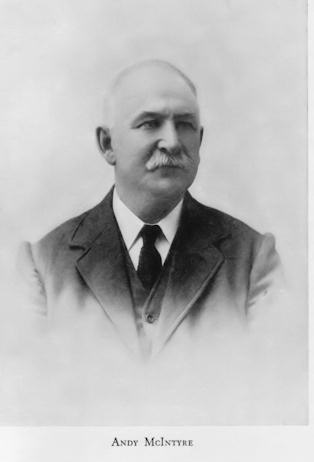 2. Andrew or Andy McIntyre, described as a man of great physique, he was a full back in the all three cup-winning teams, who played on well into the 1880’s. He also won 2 caps, both against England, in 1878 and 1882.
2. Andrew or Andy McIntyre, described as a man of great physique, he was a full back in the all three cup-winning teams, who played on well into the 1880’s. He also won 2 caps, both against England, in 1878 and 1882.
He was an engineer to trade until his retiral from Dalquhurn Works. He was typically described as “a true sportsman, a delightful personality who loved recounting the old days of Scottish football”.
When he died at his home in Middleton Street, Alexandria, aged 85 in March 1941, Andy was the last surviving member of the Old Team. With his death the last link with the Old Vale Team of over 60 years before was finally broken.
Click Image to Enlarge >
3. Archie Michie, full back in the first cup-winning team of 1877.
4. Will Jamieson, half-back of the first 2 cup-winning teams in 1877 and 1878
5. Sandy McLintock, one of the best loved of all the players in the Old Team. Although he was born in Paisley in 1853 he spent most of his life in the Vale. He was a full back in all 3 cup winning teams and would have won more than the 3 caps which he did, all against England 1875, 76, 80 had he not played for Burnley around 1884, moving there for a time as a professional, but returning to spend the rest of his life as a prominent Valeman. While playing in England he regularly was attacked by a small section of the Scottish football press for “selling out” and “being a traitor” for taking payment for playing the game. These attacks, which were also directed at other Scots playing in 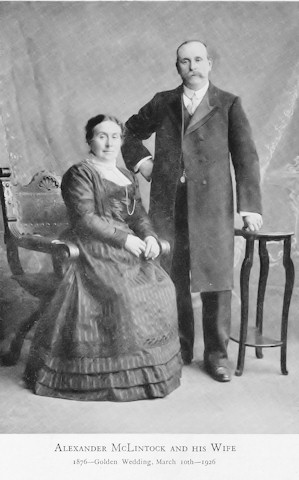 England, didn’t lay a glove on Sandy and he remained a universally popular person in the Vale and in Scottish football. Even in the 1920’s he was being described as “perhaps the greatest footballer that Scotland has produced.”
England, didn’t lay a glove on Sandy and he remained a universally popular person in the Vale and in Scottish football. Even in the 1920’s he was being described as “perhaps the greatest footballer that Scotland has produced.”
He usually played as a full back. You can see why he was so popular - he was a “good runner, a fair jumper, a fine shinty player, a good rower, a keen volunteer, a good Co-operator, a loyal Shepherd, a pioneer and past president of the Residenter’s Association” according to Allan McLean, President of the Vale FC and its first historian. He must also have had a pretty understanding wife too, because they celebrated their golden wedding – that was quite a common achievement with the Old Team players. You can well believe that he was much missed when he died in 1931, aged 78.
< Alexander “Sandy” McLintock with his wife on their Golden Wedding anniversary in 1926. A number of others from the Old Vale Team also made it to their Golden Weddings. (Click to Enlarge)
6. John Ferguson, forward in all three Vale cup-winning teams of 1877, 1878 and 1879. Also won 6 international caps – versus England (1874, 1876, and 1877), Wales (1876, 1877, and 1878). Johnny had been born and bred in Jamestown, describing himself as “a puir wee bit laudie in Jimston, sent to work at nine years of age.”
He had little formal schooling as he was always ready to admit, but soon showed a prowess for running which made him one of the leading Scottish runners of his day, at distances from 300 yards, through the half mile, to the mile. He even beat his contemporary, the great Vale runner, James McLeay, in a half mile race and had set a Scottish mile record at Powderhall of 4 min 16.5 seconds, which would still be useful to-day. So before he came to the newly-established (in the Vale) sport of football, he was already a very successful middle distance runner or pedestrian (“ped”) as they were known in those days. He ran professionally and made money at it; before he discovered football, which was still an amateur sport at that time.
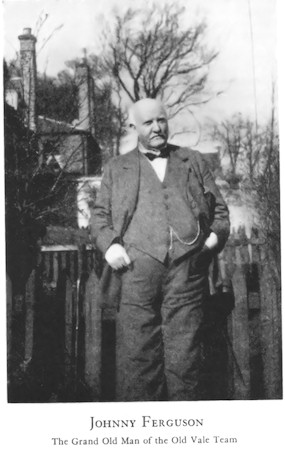 As has been said above, Ferguson became the centre of an ill thought out and inconsistent professional versus amateur controversy which kept the Vale out of the first two years of the Scottish Cup 1873-74 and 1874-75. It most certainly annoyed him, but it definitely did not hinder his performance as a player.
As has been said above, Ferguson became the centre of an ill thought out and inconsistent professional versus amateur controversy which kept the Vale out of the first two years of the Scottish Cup 1873-74 and 1874-75. It most certainly annoyed him, but it definitely did not hinder his performance as a player.
His contemporaries regarded Ferguson as one of the best and most popular forwards in Scotland, and that popularity stayed with him for the rest of a long life. Although he moved to Kilmarnock in the early 20th century, he always attended the Old Vale Team re-unions where he and his great friend John McDougall were the centres of attention. In his adopted home town of Kilmarnock, his friends threw a large party for his 80th birthday. He died there aged 81 in 1929.
Johnny Ferguson, John McDougall and he were the embodiment of the Old Vale Team and many stories were centred on him >
Click To Enlarge
7. Robert or Bob Paton (1854 – 1905), forward in 1877 Cup winning team and also Scottish internationalist with caps against England and Wales in 1879.
8. JC or Johnny McGregor – Born in 1851 or 1852 within sight of the old Cricket Park (at what is now Riverside), he was a forward who played in the first 2 cup finals, but not in the 1879 one, although he is listed on the Loving Cup as having played. He became a foreman in the UTR. As a strong Gladstonian Liberal and involved in the Co-operative Society, JC was elected to the first Bonhill Parish council in 1895. He spent his later years at 130 Bridge Street and died in 1930.
9. John McDougall 1853 – 1925, centre forward of all three cup winning teams of 1877, 1878 and 1879. The Old Vale Team captain in its glory years. He was an outstanding footballer, a close and brilliant dribbler, whose everlasting claim to fame is that not only was he the first player to score a hat-trick for Scotland, but he also had the distinction of scoring it against the English, which he did in Scotland’s 7-2 victory over them at the first Hampden Park in March 1878.
In all he won 5 caps for Scotland, scoring 4 goals. Words used by his contemporaries to describe him include modest, hard working, a true sportsman and a thorough gentleman on and off the field. A knee injury forced him into premature retirement when he was in his prime, but to his contemporaries he remained a great hero for the rest of his life.
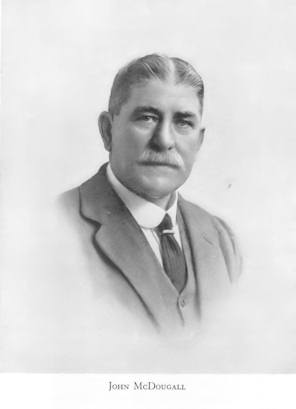
John McDougall, club captain and the first Scot to score
a hat-trick against England. Another son of the Vale,
Rentonian Alex Jackson, was to follow suite in the
1928 Wembley Wizards team. Click to Enlarge.
10. John C Baird. Born 1856 died 1902. Good, goal scoring forward who often played on the left wing. Between 1876 and 1880 he won 3 caps, 2 against England and 1 against Wales.
11. David or Davie Lindsay. Born 1853, died 13th May 1929, aged 76. Forward. He was born in the Vale and was in harness practically the whole of his life, working an astonishing 68 years at the Alexandria Works or the Craft as it was known. His funeral was attended by 6 survivors of the Old Vale Team – Johnny Ferguson, Sandy McLintock, JC McGregor, John McPherson, Andrew McIntyre and Archie Michie.
12. Robert or Bob Parlane goal-keeper of 1878 and 1879 teams. He was regarded as being tall for a goal keeper in those days, and he was about a stone heavier (at 12 st 7lbs) than any other Vale team mate, so he was very much in the mould of the present-day keeper. Parlane was a keen participant in out-field play (in those days the keeper could handle the ball outside his area) and was regarded as a bit reckless by some observers because of that. Although he didn’t play in the first cup final victory in 1876, he was the keeper in the Vale team which played Queen’s Park on January 14th 1873 to open the Vale’s new ground at Cameron’s Park. Bob won 3 international caps vs Wales (1878 and 1879), and England 1879. In 1888 he was a poacher turned gamekeeper when he refereed the Scotland vs Ireland international at Cliftonville’s ground in Belfast. He was also a keen cricketer. Belfast was his home in later life although he did return for some of the Old Vale Teams re-unions and at the 1905 re-union the Loving Cup was passed into his hands for one year’s safe keeping – the only time it has left Scotland.
13. John C or Jack McPherson (1855 – 1934) was Vale’s most capped player winning 8 caps – versus England (1879, 1880, 1883, and 1884), Wales (1879, 1881, 1883,) and Ireland (1885).
He was a half-back in the 1878 and 1879 cup-winning teams, and played in the game against Wanderers at what we would now call left back. In later years he was the man who kept the Old Team network going, acting as correspondent with those who had left the Vale, and helping to organise the Old Vale Team re-unions with James Ferguson, who was paying for them.
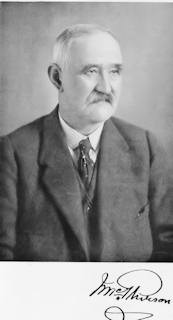
John or Jackie McPherson in later years organiser
of the outings of the Old Team. Click to Enlarge
14. James or Jamie Baird, very distinguished looking in later life with his goatee beard, and therefore easy to pick out in Old Vale team re-union photos. Centre forward in cup-winning teams of 1878 and 79.
< James Baird (Click to Enlarge)
15. Johnny McFarlane
16. James McIntyre. Full Back. He played in the Vale Team of 1879 and for some years after that. By the early 1880’s there were in fact three McIntyre’s playing for the Club – Andy mentioned above, James and a D McIntyre who was a very successful forward.
When James retired from football he was in business in Alexandria, but about 1900 he emigrated to Vancouver to work for the Canadian Pacific Railroad and retired in British Columbia.
James McIntyre on the veranda of his retiral
home in BC about 1928. Click to Enlarge >
17. Peter McGregor, forward in the 1879 cup-winning team, he is the man who was omitted from the Loving Cup, his place being wrongly attributed to his name-sake JC McGregor. So far nothing more is known about him.
Gradually throughout the early 1880’s a new generation of players was introduced by the Vale, many of whom were at least the equal of their seniors. However the other big change which affected the whole of small-town Scottish football and not just the Vale was that professionalism was openly adopted into football, firstly in England, but also inevitably in Scotland. It didn’t come without a rear-guard action from the SFA, but it was a losing battle which only generated another bout of hypocrisy and outright deceit from many Scottish clubs as well as the SFA, and arguably the delay in introducing professionalism in Scotland actually hastened the Vale’s decline.
Many of the best young players were drawn away to clubs in England who could pay the players years before Renton and the Vale were allowed to do so officially. The vastly greater supporters’ bases of these English clubs generated far greater revenues and made it inevitable that many would go eventually anyway. However, the decline was steeper and further than it need have been. And, of course, there was no way back. Still, they were great while they lasted, the Vale’s days in the spotlight as the Cradle of Scottish Football.

